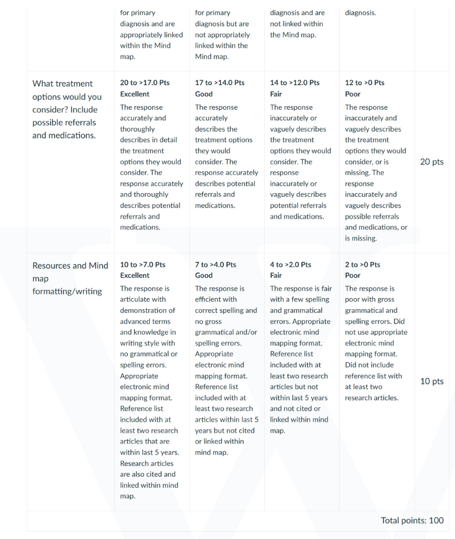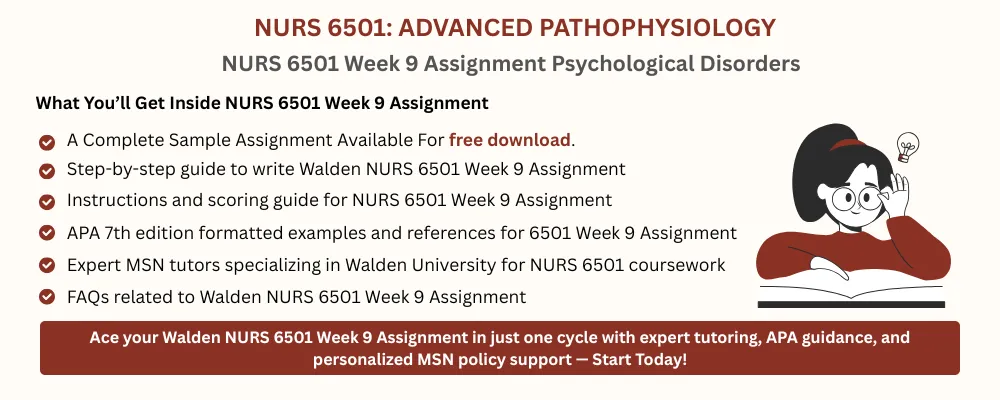NURS 6501 Week 9 Assignment FREE DOWNLOAD
NURS 6501 Week 9 Assignment
Psychological Disorders
Student Name
Walden University
NURS 6501: Advanced Pathophysiology
Professor name
Date
Concept Map Template
Primary Diagnosis: Major Depressive Disorder (MDD)
Describe the pathophysiology of the primary diagnosis in your own words. What are the patient’s risk factors for this diagnosis?
Pathophysiology of Primary Diagnosis | |
Depression pathophysiology is highly polygenic, with thousands of variants influencing serotonin, dopamine, and BDNF signaling, leading to impaired neuroplasticity and stress resilience (Cui et al., 2024). Major Depressive Disorder (MDD) results from multifactorial impairments in brain chemistry, stress regulation, and immune function. Traditional monoamine hypotheses highlight deficits in serotonin, norepinephrine, and dopamine signaling, which underlie low mood and anhedonia. Chronic stress triggers hypothalamic–pituitary–adrenal (HPA) axis hyperactivity, causing prolonged elevations in cortisol that impair hippocampal neurogenesis and encourage neuronal atrophy. In parallel, neuroinflammation—marked by increased cytokines IL-6 and TNF-α—redirects tryptophan metabolism towards neurotoxic kynurenine metabolites, further reducing serotonin and intensifying glutamatergic excitotoxicity (Kouba et al., 2024). Genetic susceptibility (e.g., SLC6A4, BDNF) and early‐life adversity converge epigenetically to increase vulnerability, as decreases in BDNF and EGF impair synaptic plasticity, reinforcing depressive phenotypes. | |
Causes | Risk Factors (genetic/ethnic/physical) |
Major Depressive Disorder is caused by the interplay of genetic, neurochemical, inflammatory, and neuroplastic changes. Genomic studies have identified thousands of small-effect variants that converge on neurotransmitter systems (serotonin, dopamine), neurotrophic factors (BDNF), and stress‐response pathways (HPA axis) (Cui et al., 2024). Microglial activation and peripheral cytokines induce neuro-inflammation that disrupts tryptophan metabolism, lowering serotonin availability and synaptic plasticity. | · Genetic/Ethnic: MDD family history; SLC6A4, BDNF, and FKBP5 gene polymorphisms (de Menezes Galvão et al., 2021). · Physical: Chronic diseases (e.g., cardiovascular disease), sleep disorders, and HPA-axis dysregulation due to chronic stress (Kouba et al., 2024). · Environmental: Early‐life trauma, social isolation, and socioeconomic adversity epigenetically alter stress-response genes, enhancing vulnerability. |
What are the patient’s signs and symptoms for this diagnosis? How does the diagnosis impact other body systems and what are the possible complications?
Signs and Symptoms – Common presentation | How does the diagnosis impact each body system? Complications? |
· Persistent depressed mood and anhedonia (lack of pleasure). · Sleep disturbances can manifest as hypersomnia or insomnia. · Changes in appetite/weight loss or gain. · Psychomotor agitation or retardation. · Fatigue, low energy. | · Neuroendocrine: Hypercortisolemia due to HPA-axis overactivity → metabolic syndrome, osteoporosis. · Cardiovascular: Inflammatory marker increase and platelet activation → higher risk of myocardial infarction and stroke (Cui et al., 2024). · Immune: Chronic inflammation increases vulnerability to infections and autoimmune diseases (Kouba et al., 2024). · Cognitive: Impaired concentration/memory raises risk of dementia and functional decline. · Psychosocial: Social withdrawal, occupational impairment, and increased suicide risk (Cui et al., 2024). |
What are other potential diagnoses that present in a similar way to this diagnosis (differentials)?
· Hypothyroidism (E03.9): May simulate depressive symptoms—fatigue, weight gain, low mood—ruled out by TSH assay. · Bipolar II Disorder (F31.81): Has depressive episodes but with history of hypomania—screen with Mood Disorder Questionnaire. · Adjustment Disorder with Depressed Mood (F43.21): Depressive symptoms due to identifiable stressor—remission within 6 months of stress resolution. |
What diagnostic tests or labs would you order to rule out the differentials for this patient or confirm the primary diagnosis?
· PHQ-9 Questionnaire: Standardized screening instrument for depression severity. · Thyroid Stimulating Hormone (TSH): To rule out hypothyroidism. · Complete Blood Count and CMP: • To diagnose anemia, electrolyte abnormalities affecting mood. · Serum B12 and Folate: Deficiency can manifest with depressive-like behaviour. · Urine Drug Screen: To exclude substance-induced mood disorder. |
What treatment options would you consider? Include possible referrals and medications.
Pharmacologic · First-line Antidepressants: SSRIs (e.g., sertraline 50 mg daily)—well tolerated with evidence of efficacy (Tian et al., 2022). · Rapid‐acting Agents: Ketamine infusions for treatment-resistant depression. Non-Pharmacologic · Cognitive Behavioral Therapy (CBT): • Meta-analyses demonstrate strong improvement in MDD symptoms compared to control (Cuijpers et al., 2023). · Physical Exercise: Aerobic exercise decreases inflammatory markers and enhances mood. · Mindfulness‐Based Stress Reduction (MBSR): Enhances HPA-axis regulation and reduces rumination. Referrals · Psychiatry: For refractory or complex cases needing advanced interventions (ECT, TMS). · Psychology/Counseling: For group or individual therapy modalities. · Social Work/Psychosocial Support: To counteract socioeconomic and environmental stressors. | |||
Struggling with your NURS 6501 Week 7 Assignment Neurological Disorders? Click here to boost your performance!
Instructions To Write NURS 6501 Week 9 Assignment
Need instructions for this assessment? Contact us now and get expert guidance right away!
Instructions File For 6501 Week 9 Assignment
PSYCHOLOGICAL DISORDERS
In this exercise, you will complete a Mind Map to gauge your understanding of this week’s content. Select one of the possible topics provided to complete your MindMap assignment.
Generalized anxiety disorder
Depression
Bipolar disorders
Schizophrenia
Delirium and dementia
Obsessive compulsive disease
RESOURCES
Be sure to review the Learning Resources before completing this activity. Click the weekly resources link to access the resources.
WEEKLY RESOURCES
BY DAY 7 OF WEEK 9
Submit your MindMap by Day 7 of Week 9
NURS 6501 Week 9 Assignment Rubrics


References For NURS 6501 Week 9 Assignment
Cui, L., Li, S., Wang, S., Wu, X., Liu, Y., Yu, W., Wang, Y., Tang, Y., Xia, M., & Li, B. (2024). Major depressive disorder: Hypothesis, mechanism, prevention and treatment. Signal Transduction and Targeted Therapy, 9(1). https://doi.org/10.1038/s41392-024-01738-y
Cuijpers, P., Miguel, C., Harrer, M., Plessen, C. Y., Ciharova, M., Ebert, D., & Karyotaki, E. (2023). Cognitive behavior therapy vs. control conditions, other psychotherapies, pharmacotherapies and combined treatment for depression: A comprehensive meta‐analysis including 409 trials with 52,702 patients. World Psychiatry, 22(1), 105–115. https://doi.org/10.1002/wps.21069
de Menezes Galvão, A. C., Almeida, R. N., de Sousa, G. M., Leocadio-Miguel, M. A., Palhano-Fontes, F., de Araujo, D. B., Lobão-Soares, B., Maia-de-Oliveira, J. P., Nunes, E. A., Hallak, J. E. C., Schuch, F. B., Sarris, J., & Galvão-Coelho, N. L. (2021). Pathophysiology of major depression by clinical stages. Frontiers in Psychology, 12. https://doi.org/10.3389/fpsyg.2021.641779
Kouba, B. R., de Araujo Borba, L., Borges de Souza, P., Gil-Mohapel, J., & Rodrigues, A. L. S. (2024). Role of inflammatory mechanisms in major depressive disorder: From etiology to potential pharmacological targets. Cells, 13(5), 423. https://doi.org/10.3390/cells13050423
Tian, H., Hu, Z., Xu, J., & Wang, C. (2022). The molecular pathophysiology of depression and the new therapeutics. MedComm, 3(3). https://doi.org/10.1002/mco2.156
Best Professors To Choose From For NURS 6501 Class
- Dr. Mary Smith
- Dr. Tara Harris
- Dr. Mahaman Moussa
- Dr. Annaliza (Anna Liza) Villena
- Dr. Morgan Skinner
(FAQs) related to NURS 6501 Week 9 Assignment
Question 1: Where can I download a free sample for NURS 6501 Week 9 Assignment?
Answer 1: Download a free sample from Tutors Academy.
Question 2: Where can I find the rubrics and instruction file for NURS 6501 Week 9 Assignment?
Answer 2: Get the rubric and instruction file from the Tutors Academy website.
Do you need a tutor to help with this paper for you with in 24 hours.
- 0% Plagiarised
- 0% AI
- Distinguish grades guarantee
- 24 hour delivery

